No matter what grade of plywood you need to paint, they’re almost all the same. Let’s start by looking at the right paint for plywood, then move on to the details of painting plywood.
You can also jump below to:
- Paint plywood—how to
- Painting plywood floors? Special paint, with some cool stencil ideas, jump to it (along with some very cool plywood tricks like iron-on glue banding, etc).
- A full shopping list for painting plywood and more
The primer is the most important:
The one thing you’ll definitely need for painting new plywood is the proper plywood primer and this one is excellent: don’t use just any primer!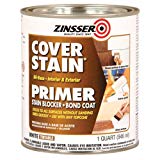
The wrong primer will allow ‘knots’ to bleed through and will also make the wood grain bumpy.
All wood has layers of soft/hard/soft grain. Get them wet and the soft grains swell more than the hard and this creates a bumpy surface. Big time sanding. A world of hurt. Mucho problemo.
A water-based primer creates this problem. Oil-based primers, like this Zinsser shown here, will not. But, that is not all.
All plywood, but especially grades lower than ‘A’, have tree knots that contain resins that will bleed through primers that are not designed to block stains. And that resin will bleed through 100 topcoats of paint in time.
Apply liberally.
There is a bit more on primer below in the ‘how-to’ section.
Which Paint? Five good choices.
So many paints, so little time. A typical shelf or plywood project is done with semi-gloss (like other woodwork). The best way to paint plywood to last is to use the best paint for plywood that you can afford.
Drum roll, please…
5. A decent quality plywood paint is Kilz Tribute Semi-gloss which comes in many colors: click through the related pages to find the family of blues, greens, etc that you like.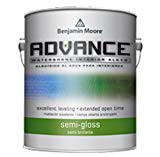
4. There is no better semi-gloss white on the market than Ben Moore’s Advance. It’s water-based but goes on and looks like oil. Practice in test spots and watch how much will drip in the first ½-hour. It’s tricky but worth it. Don’t let the high price fool you: it really lasts and looks great. Message this seller after your order and specify color. Ben can make it in any color (BM website chart).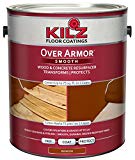
3. Kilz Over Armor fills cracks and evens out to hide imperfections. Do some testing: use latex caulk after the primer to fill big cracks. Three colors, Chocolate, mmm, chocolate, Slate, and Redwood.
2. Floor Tough: A very durable paint from none other than Ben Moore comes, Tough Shield. This is the go-to floor paint that I recommend to every customer. Spending a little more up-front saves money in the long run because quality lasts longer. It’s our prime directive, Captain.
Number 2 above is really my top pick, but here is another way to go:
1. A modern idea used for painting plywood shelves, furniture, etc., is chalkboard paint which dries very smooth and flat (for chalkboards). When it’s dry, cover it with a clear satin or gloss Polyurethane. It looks like a spray job. Sixteen nice colors.
If you do want a sprayed look for any paint, read my view on the best homeowner sprayers on the market today.
How shiny?
• Semi-gloss and high-gloss finishes are easier to clean when dry and this is what we almost always use to paint shelves and doors, etc.
• Flat or Satin: not recommended for anything you will touch as it marks easily and is not easy to clean.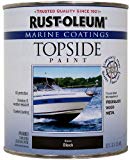
- Oil-based paints are a world of hurt but look great. This is an awesome, tough white gloss from Rust-oleum. Wear the same respirator we wear (the filters are shown on this page).
- A latex high-gloss is best in marine paint: they dry quite hard. Nine colors. If you’re painting plywood that will be outside, as in a shed, go with this.
You can get a very smooth latex finish (no brush marks) by adding Floetrol to water-based paint. It slows the drying time allowing brushstrokes to flatten out.
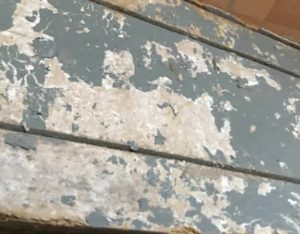
Going Clear? Varathane is still king. It comes in satin, semi-gloss, and gloss: interior use only. Note: if not going over paint, it’s used mostly for furniture grade plywood (imperfections show in lesser grades). (Varathane has a cool website.)
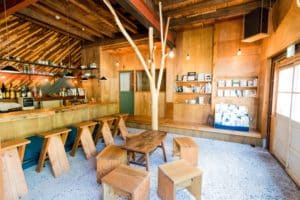
How to Paint Plywood
1. Filling holes, imperfections
2. Sanding and cleaning
3. Primer is Pivotal
4. Painting is the easy part
5. Clean up secrets
Tip: Vacuum the floors all around the project (this keeps dust from flying into your paint.) What would I do without my shop-vac?
1. Fillers
Big tip: With a damp rag, wipe what you’ll paint very well. Small dust will be noticeable.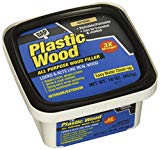
- What to filler use? For furniture/shelves etc, use Plastic Wood. It’s very hard to sand, but dries, well, hard. For floors, see the bottom of this post on floors.
- Apply with a putty knife wider than the biggest hole.
Note: thick patches may shrink, so let dry and if needed, just top them off with more coats.
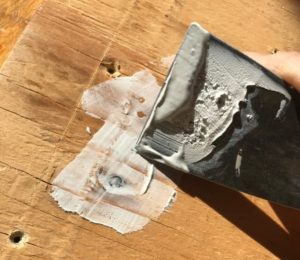
2. Sanding plywood and cleaning: make it or break it
Furniture-grade plywood is great (and pricey), but if you bought the 40 dollar stuff, elbow grease will bring it up a level. We’d recommend getting at least medium-grade for not even a fist full of dollars, Clint.
Why do higher grade plywoods cost so much more? Because sanding plywood takes time and money.
Can you turn medium grade into furniture grade plywood? Yes, if you are going to paint it. Fill the gaps and knots and sand baby, sand.
• Sand the entire surfaces at the same time you sand the dry hole-filler.
With what? Start off with 100-grit (medium-rough) then go finer and finer (higher numbers) up to 220 for very fine cabinet-level work. This is a variety pack.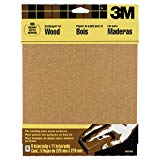
• Clean the dust off with your shop vac or a barely damp rag (or use rubbing, a.k.a. denatured alcohol-soaked rag). You don’t want it water—wet, ever.
3. Primer is Pivotal (if the plywood not coated already)
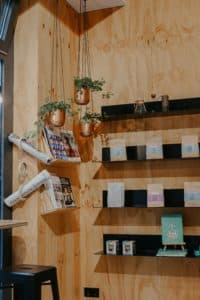 Plywood primer of some kind is a must: plywood is a composite with all kinds of wood knots and glues and resins and you have to seal them or they will bleed through into your topcoat. I explained above about the hard/soft grain and the need for a primer.
Plywood primer of some kind is a must: plywood is a composite with all kinds of wood knots and glues and resins and you have to seal them or they will bleed through into your topcoat. I explained above about the hard/soft grain and the need for a primer.
Quality primer also creates bonding between wood and topcoat. Ever see wood with paint chipping off? Bad primer.
I don’t really recommend paint and primer in one “as seen on TV”. There are times it is useful, but not here. Some disagree. Read this forum about the danger of screwing it all up with paint-primer-in-one.
Check for sags, runs, errors, and any men left on base. Depending on drying time, these errors can develop after you think you are done. Dry drips? Just shave them with a razor and try lightly sanding (sanding latex is almost impossible).
4. Painting time
- Did you miss our choices for the best paint for plywood? See them at the top.
- How do pro painters go so fast? A roller to spread the paint (makes a very even coat), then “tip it out” paint with a good brush.
- Your lifetime brush and roller are under “Shopping List“ below. Don’t go low-budget on the brush or roller as they fall apart when wet. There outta be law.
- Between coats, inspect. Do you see any holes you forgot to fill or that shrank? Just hit them again, let dry, sand and then prime/paint to catch them up.
- Read the paint can label on re-coating time. There is both a minimum and a maximum. If you wait too long, you have to sand between coats.
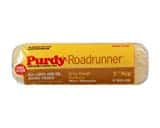 Walls? Done right, people will not know you have painted plywood walls. Painting plywood walls are the same as painting any walls after the prep is done. Choose a thicker nap when you get your painting roller cover: maybe about 1 inch.
Walls? Done right, people will not know you have painted plywood walls. Painting plywood walls are the same as painting any walls after the prep is done. Choose a thicker nap when you get your painting roller cover: maybe about 1 inch.
Tip #1:
You may be able to save time and paint by tinting your primer. Careful: too much tint reduces the ability of the primer to do the job you are paying for. Aim for a light gray in most cases: by adding black tint. Almost all colors cover gray amazingly well. You might not need a 3rd coat (2nd top-coat). When painted with red, definitely use a dark gray primer. You’ll need many coats if you don’t. It’s a weird phenomenon.
Tip #2:
Most paints will not fill tiny cracks, but thicker paint helps here. Kilz Over Armor is good for this.
Tip #3:
Those websites telling you to ‘brush with the grain’ or ‘brush against the grain’? Bunk. It does not matter at all. Primer is key: do it well. That’s it.
5. Clean up is very easy
Clean your brush: wire brush the dried crud (handle too) and pound the heck out of the bristles under warm water until 98% clean (more details: 5-minute read). Comb straight to dry: it will be line new next time. Easy. (Video demonstration). NOTE: don’t use budget wire brushes, especially in the sink. The bristles fall out and end up in the drain.
To quickly clean the roller: squeegee most of the paint back into the bucket, then soak it in a bucket overnight: the rest of the paint will settle to the bottom. (Details: a 5-minute read). We use ‘spinners’ (see video).
Quality tools are hard to kill. A Purdy latex brush lasts us 6 months of daily use: all day long.
General plywood painting and other tips:
- Plywood caution: Ask the store if the wood is from China: there is a lot of junk going around (the layers come apart).
- Building something? The best way to paint plywood: do it before cutting it. Then just touch-up the edges where you cut: this saves a lot of time.
- All you ever need to know about plywood (every type of composite) is on this Wikipedia entry.
- Here is a great video all about the types and uses of plywood and composites.
- Spray painting plywood is probably the best way to go if you have a lot: here is a post on 3 sprayers for 3 budgets.
Time out: A plywood guitar? Yes, a very expensive plywood guitar: a 1929 or 1930 Dobro. Owned by Robert Johnson! Not. See the very bottom.
Painting Plywood Flooring (and Using Stencils)
How to make any floor a non-skid floor: there’s a trick. Look for “texturing sand” at the bottom of this article.
Nowhere will you find any floor covering for less than a dollar per square foot except for painting plywood floors.
We priced the cost (including tools, see our list here), at about 50¢/sq.ft. Wow. Clearly attractive. Laminate ‘click flooring’ is 4-x to 16-x as much.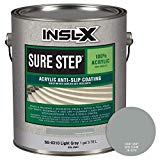
There are two basic choices: Benjamin Moore’s INSL-X non-slip floor paint, which comes in 6 colors. There is also a decent Kilz product. You need to like gray for that.
White? White floor paint is surprisingly hard to come by. Valspar is a good choice. In two ‘shades of gray’.
More on floor paints are in my post on the best floor paint. Painting a floor is the easiest thing we do as professional painters. Cha-ching, the money maker. We have a post about the best basement floor paint, that’s all about painting floors (it’s not just for basements), that discusses how/when to move furniture, etc.
Be glad and read about how filthy carpet can get.
Note: Plywood is softer than other floor coverings, so you’ll get some dings….easy to fix and touch up as well if you like, but most dings will disappear in any floor stencil pattern.
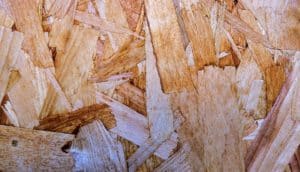
How to paint plywood flooring:
- Remove or set any nails/screws and fill with Goodfellas. Don’t use floor leveler! It cannot be sanded.
- Follow the procedure for painting plywood above but use floor paint: specially designed for floors (more just above).
- Plan it out: move furniture, paint in sections.
- Read the post on protecting fresh floor paint.
- Color tips below.
Very cool: stencil the floor after painting
Paisley Allover is a nice pattern to start your search with. 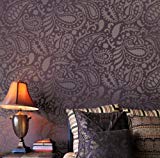
Key tips: this requires one coat (only) over your painted plywood floor or wall.
- Stencils come with full instructions (videos like this too).
- Bigger stencils will make the go work faster.
- A mini roller with a thin foam nap may be the best application method for DIY’ers.
- For 9 inch rollers, get a good foam roller cover from Wooster: not expensive. Easy to clean and keep!
The steps:
- Simply lay the stencil in place, secure with painter’s tape, then paint your accent color.
- Use painter’s tape (only) to hold in place while painting. (It has special glue that will not pull off recently applied paint).
- Roll or brush your roller over your stencil.
- Clean the stencil after each square: don’t let the paint dry on it and you’ll keep the lines sharp.
- Repeat.
Tip: To clean the stencil you will need a water basin and old towels.
Colors that work together:
Bold choices might sound good, but looks sort of ’70s. Go neutral, earthy.
The bottom color is the background. If the stencil color skips etc, you can touch-up with an artist’s brush.
Most floor paint is some shade of gray etc. I recommend colors suggested by these architects.
They say gray goes with black, rose, green mint, cherry, sunny yellow, aqua and more. Try black over gray. Nice.
Banding: the illusion of wood.
Banding with wood band strips: easy to apply with an iron. See my video below for how to make paintable plywood edging for almost no cost but it is not nearly as nice as banding the edges. 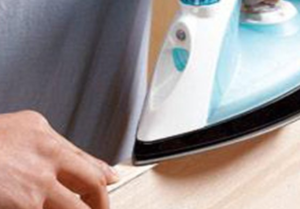
Shopping list for painting plywood: choose your weapons
Main Tools:
- The full tool list: all you will ever need.
- See how easy it is to clean up. Make tools last a lifetime.
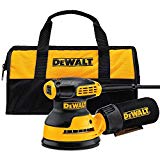
- Other necessities If you’re doing a lot of sanding, you’ll love having your palm sander. Good price for such quality. It does not require specialty paper. Whoever thought up sanders that need special paper?
- This sander uses any “hook and loop’ circular paper, which is basically like velcro. This sandpaper box is a deal with 100 pieces, every grit you could want, and almost perfect reviews.
- Masking tape: Pros don’t use it to mask except for weird angles, but it may make you more comfortable. I use it all over the house because it won’t leave a glue mark. Mostly for painting, I use it to hold up plastic, etc. A pack of six is the best deal.
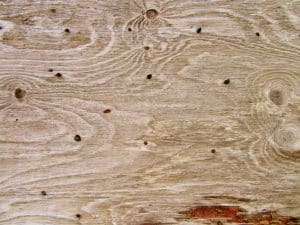
Related Links:
How Many Coats of Primer for Any Situation? You’ll Like the Answer.
Best Floor Paint: Only 1 Coat!
Best Basement Floor Paint & Painting floor in 5 steps
Painting Tools List (with 5 BIG TIMESAVING Paint Tools)
Did we forget anything? How to paint plywood ‘XYZ’? I hope we covered it all, but you never know. Let us know in the comments below.
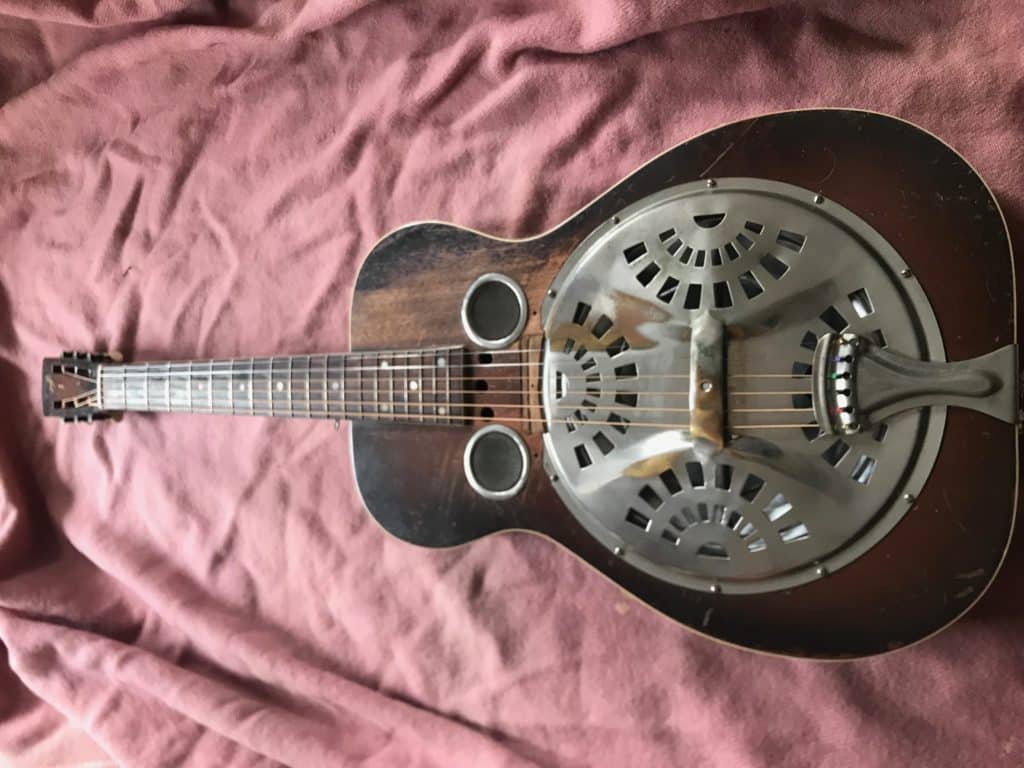
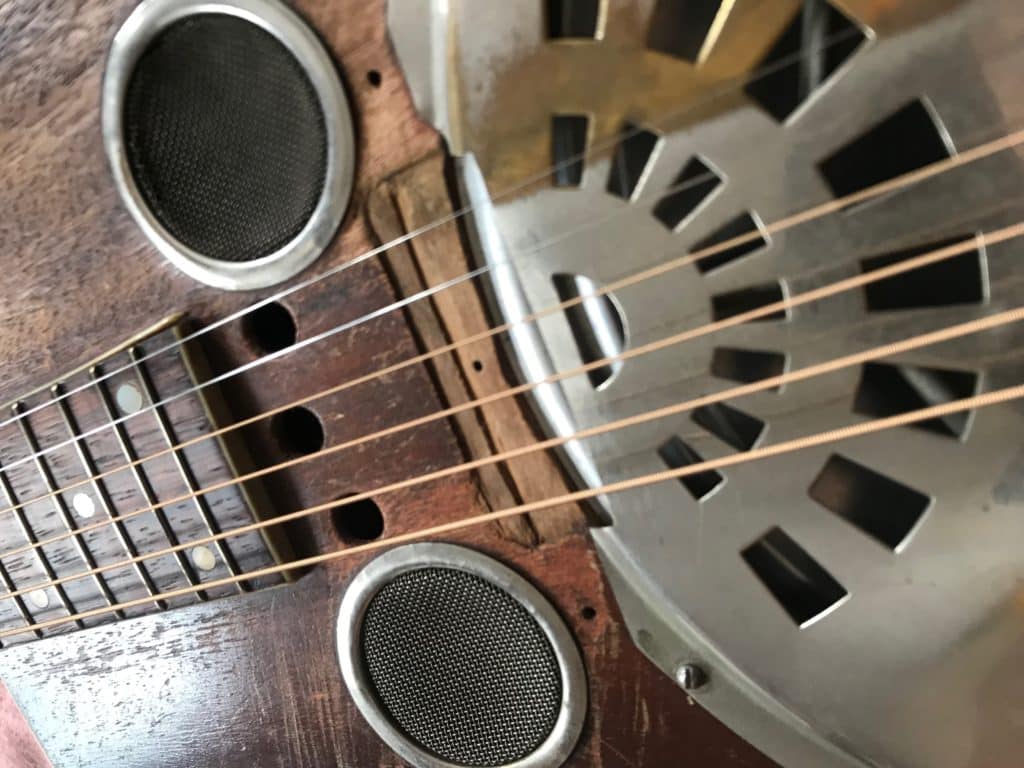

I’m painting particle board flooring in my mother’s house. I’m putting Kilz down first. What size and type roller would work best for large areas?
A 9″ 50% wool 50% nylon as seen on my tools page. It’s what I use for almost everything. Just know that you need a good bonding primer and give the floor a light sanding and clean well before primer. Two thin coats will be key. Good luck.
Brad
Hi Brad!
I’m going to be painting a plywood floor for a yurt and I have a couple questions. The floor will be built in sections so it can come apart. My question is, would it be better to paint these individual sections before they go together, or after? Thanks!
Definitely, because the paint will crack when you dismantle it if it bridges the gap. Not sure of how you set it up, but know that paint will build and if you paint the edges it may increase the gap between floor sections.
Also, if it will freeze even if when in storage, you have to use exterior paint. But don’t paint with that if the sections are inside: if you do, open windows and wear a good chemical respiraotre. Exteriors have nasties.
Hi Brad,
We just bought a prefab garage that has a bare plywood floor. It’s going to be our wood workshop. What paint would you recommend thats very durable and goes on a plywood floor? There’s going to be a decent amount of traffic.
Thanks in advance!
Think big, think long term. If it were mine, I’d plan on touching up every year or two in the traffic areas. Therefore I want the LEAST amount of prep. That means latex, not oil.
So the best of the best is GarageGuard.
Actually, if it were me, I’d go with garage tiles: one and done. I got a sample and they are very hard plastic and won’t crack when you drop the vise that just missed your toes.
This post lists all types in the spectrum.
Good luck!
Hi Brad,
Really glad I came across your site! I am fixing up a place I am renting. The floors throughout the home were replaced with particle board, the water resistant kind.
I primed and painted all the floors before moving in but not with a real floor paint. Time and cost were motivators at the time..
The kitchen finally was finished with linoleum as well as the bathroom. The rest of the floors will remain painted. I now am able to paint with the proper paints for floors and I am hoping that all I need to do before applying the new paint is to lightly sand the floor, wash it, let it dry and then paint it. The floor is a dark/milk chocolate brown but I may change out to a medium/dark blue tone.
Is there anything more I need to do before painting? Also, in your opinion, is Ben Moore Tough Shield the best option?
Thank you in advance for any suggestions!
Lori
Particle Board? Seems unlikely. That stuff is just chips of wood glued together. Are you sure? Could it just be plywood?
In any case, yes, sand and prime the bare spots, then I do like Tough Shield but there are others. I always say ‘pay them now’ don’t pay later…because it’s scraping, sanding…ufff.
Good luck
B
I want to paint or primer the ceilings in my kitchen they left the raw and I need to primer them what kind of primer or paint should I use.
First, you don’t want to leave just primer because it’s white. It will not last long at all. You have to coat it.
So, if you mean ‘raw’ to be drywall that’s never been painted (write again if not), use basic drywall painter and Ben Moore’s ceiling white. One coat of each. The products are best seen on this post for primer and this for paint.
Good luck. B
Well done, nice article!
I’m repainting a plywood floor in a screened in porch. After I’ve sanded it which primer do you recommend? Using Tough Shield for the final coat(s).
Every floor is different. If it’s outside, of course it must be exterior primer. Tough Shield is great as your top coat and since you are going quality, why not use the best: Ben Moore’s Fresh Start. Probably you should use the oil version as you have pine in your plywood. It stinks, but that is what I would use.
https://www.benjaminmoore.com/en-us/interior-exterior-paints-stains/product-catalog/fspep/fresh-start-premium-exterior-primers
The 024 is the one for me.
I might use Stix also, which is water based.
Good luck
It has been suggested that I use drywall joint tape with plastic wood to fill large holes in plywood. Just looking for another opinion.
I’ve never heard of that, sorry. Plastic wood maybe…
Good luck,
B
I want to paint White a stained plywood ceiling on a screened in porch . Knots and holes had been filled in by previous owners. Which Primer And paint would you suggest? Should I sand it first?
Yes, I’d would sand with probably 80 grit…fairly rough paper.
I’d also pressure wash after sanding and let bone dry.
Then use PrimeLock, exterior ok and provides very good bonding between coats. It’s oil based so have paint thinner handy …and that citrus handcleaner is the way to clean skin!
Good luck!
b
Thank you
Can I paint my particle board subfloor? Doesn’t have to last forever-
If you going to walk on it for a while, sure. If you might put glue on it later, I’d say no. But if you will later cover with another non-glued floor, seems good to me.
Use a primer only perhaps. They can always be painted. Many paints would need sanding.
Hope I understood the question.
B